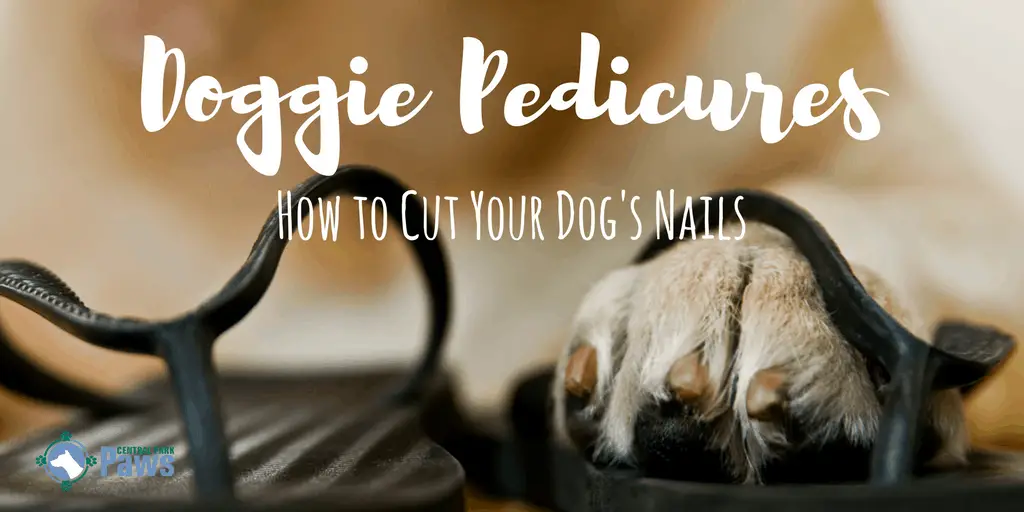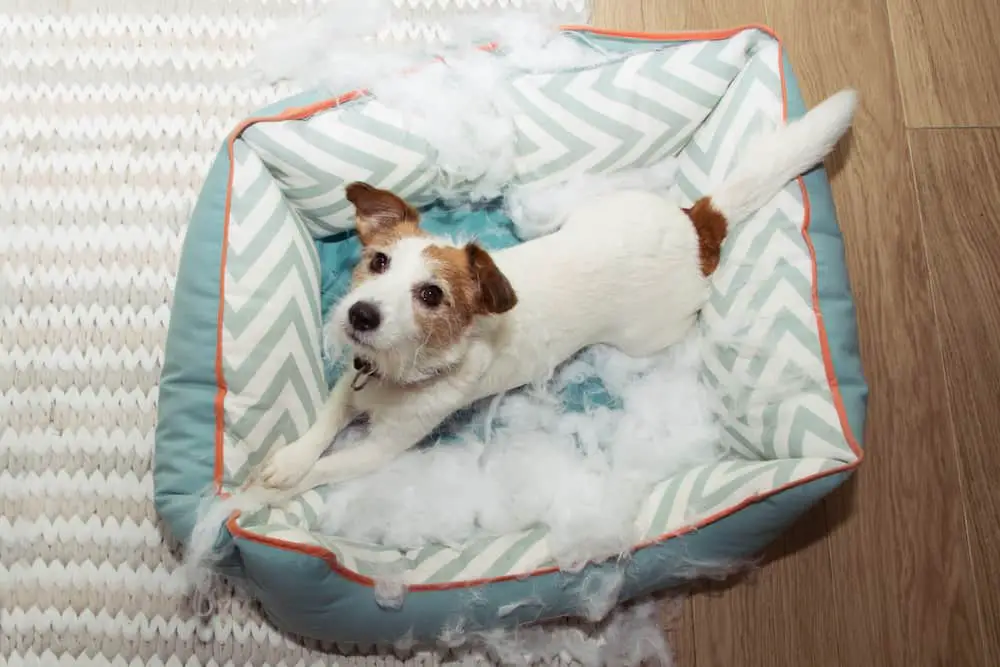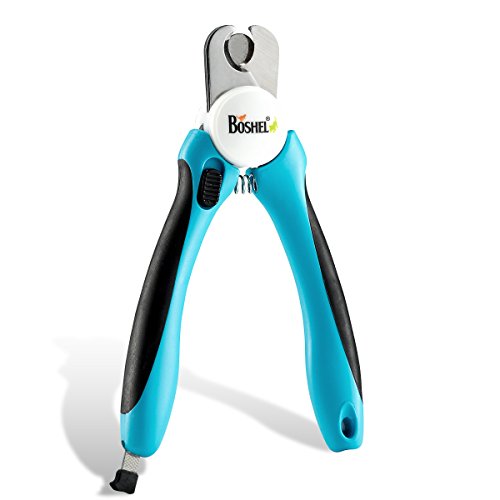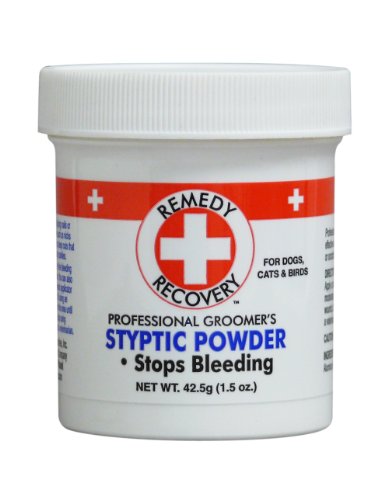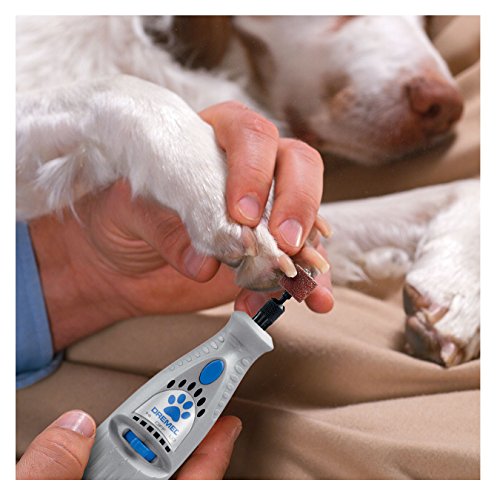Ever watch a rodeo, with these cute little kids are dressed up in their cowboy and cowgirl gear, chasing a baby pig?
Yeah – that’s what I walked into at my friend’s house a couple weeks ago.
But without the kids cowboy boots. Or the pig.
My friends recently adopted their first family dog and asked me to come over and help to trim his nails.
When I got there I found myself more interested in the entertainment unfolding in front of me as I leaned up against the fence with my cup of coffee and watched as FOUR grown adults ran around the backyard trying to catch an adorable red-nosed pittie that was having the time of his life.
I know I shouldn’t laugh, but I couldn’t help it. Watching half an hour of keep-away was more entertaining than the Winter Olympics.
Once I decided the pup had enough of his wiggles run out, I called him into their house and up onto the couch, and gave them a crash course in nail clipping.
It took a few minutes to figure out why I was being glared at – I mean, I had stopped laughing … Eventually.
Apparently the dog wasn’t supposed to be up on the couch. Who knew?
I wondered if it was a good time to tell them that one of my dogs will actually fall asleep while getting his pedicure.
Related: How to Grind Dog Nails at Home
Let’s Get Started
Pedicures are wonderful.
Doggie pedicures, on the other hand – notsomuch.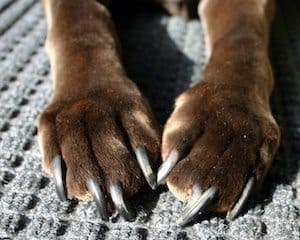
Unfortunately, most canine parents aren’t familiar enough with the process of cutting nails, and dogs are naturally opposed to having their feet touched, so it can quickly turn into a battle of wills that no one wins.
We’d like to help you avoid that – as well as saving a few bucks grooming, and enhancing your relationship with your four-legged kid at the same time.
Related: How to Get My Dog to Like Nail Trims
How to Clip Dog Nails – Step By Step Guide
The actual steps for trimming your dog’s toenails is surprisingly straightforward…
Grab a Paw
Gently hold the foot, separating the toes.
Trim the Hair
If needed, trim a small amount of paw hair away from the nails for the best possible view.
Clip the Tip
Cut a little nail at a time, at a 45° angle, keeping watch for signs of encroaching on the vascular quick[1] (kwik).
Cut the Rest
Stop when you see a pinkish area, or whitish if you’re trimming black nails. This usually lines up with the slight notch on the underside of the nail – if your dog has one.
Repeat
Repeat with the next nail.
Finish
Don’t forget to trim the dew claws[2]!
Tips for Clipping Your Dog’s Nails
The hardest part of trimming nails is actually getting your hands on the slippery little piggies. Historically, dogs do not like having their feet messed with, so this needs to be overcome through gentle, trust-building exercises.
Or treats. Lots and lots of treats.
With my dogs, I have them lay down and I trim one nail at a time, and they get a treat for each. Laying down helps them relax, and makes the job easier to do – allowing you to relax as well.
Snip, treat. Snip, treat.
Pretty simple.
It helps if you burn off their excess energy, first.
If your dog isn’t accustomed to cutting or acts like he’s being tortured, place the cutters near his head where he can smell them and alternate a toe rub with a treat.
Rub, treat. Rub, treat.
Slowly work up to the clippers as you gain your dog’s confidence.
The best advice we can give you, if you’ve never done a doggie pedicure before and you’re nervous about it, is to have your vet or groomer show you how to clip your dog’s nails.
But since that’s not always possible, here are some suggestions of what to do – and what not to do.
Do …
- Get the wiggles out. A calm doggie is much more cooperative than a spastic one.
- Make sure your pup is familiar with all aspects of the pedicure. This includes letting then sniff out the tools you plan to be using.
- Make sure you can handle and manipulate your dog’s feet. If they don’t like to have their feet or toes touched then you’re going to have a hard time cutting.
- Give treats liberally.
Don’t …
- Never tie down your dog; this is traumatic not only for you but for your pup as well.
- Never use the wrong tools. Sharper may be faster, but it’s easier to have an accident.
- Never clip without a plan – or treats.
Tools For The Job
The secret to true happiness in life (aside from a yard full of puppies) is having the right tool for the right job. So before you jump feet-first into unfamiliar territory, make sure you have all your tools all in a row. Literally, each one of these five items laid out within arm’s reach;
1. Cutters
There are really only two styles of canine nail clippers, with their own distinct uses. Like any tool, each one has its pros and cons;
Scissor Clippers
Scissor clippers look more like side cutters (that you never use to cut your dog’s nails!) than standard scissors. They’re more of a plier style tool than scissors, really.
These are probably the most common cutters used.
- Pro: This style is easy to use, and you’re not trying to fit the nail through a hole. These are best for large dogs with thicker nails since you can get good leverage for cutting.
- Con: If you are rushed, it is very east to trim off too much nail with each cut, increasing the likelihood of injury. Fortunately, these clippers have a guard to prevent you from clipping off too much.
Guillotine Clippers
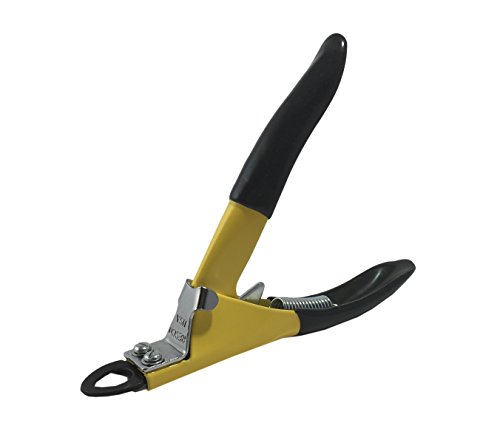
- Pro: Design makes it easier to see exactly where the cut line will be.
- Con: It’s possible a jerky dog may panic and injure themselves while their nail is in the guillotine. Also, these tend to be blunter than the scissor-type counterpart, causing incomplete cutting.
Related: How to Sharpen Dog Nail Clippers
2. Nail File
Once trimmed, there are likely some sharp edges. It might not seem like it would bother Rover, but if he gets an itch, he could easily harm his skin while scratching – not to mention playing with his two-legged siblings.
Use a nail file or hand-held grinding tool like a Dremel to gently grind your dog’s nails.
3. Small Standard Scissors
Depending on the breed of dog, you may want – or need – to lightly trim away some of the toe hair in order to be able to have the best view possible of the nails.
4. Styptic Powder
If you do not have this stop-bleeding powder on hand, do not cut your dog’s nails. Stop here and head over to your favorite pet supply store (or order this). It’s okay, we’ll wait.
5. Treats
Treats cover a multitude of sins – including sitting through a pedicure. Be generous. Be very generous.
Cutting vs Grinding
We’ve all sat through the “as seen on tv” infomercial for the painless and effective way of keeping your pet’s nails at proper length by using a special tool that smooths the nails down to the perfect length. And the canine actor is such a happy doggie to boot.
Now, forgoing everything we know about how what we can believe what we see on the television is, a grinder can actually be helpful in doggie pedicures – but there’s a proper time and place for it.
- Cutting – this is how you actually remove length. If you’ve gone too long between trimming and your pup’s nails are more like talons, you’ve got to cut them.
- Grinding – this uses an abrasive surface to remove thin layers. It’s best when used as a weekly length maintenance, or for post-cutting smoothing and rounding of the nail.
If you’ve decided to try grinding, keep in mind that not only is it the noise your dog needs to get used to, it’s the vibration too.
It really is painless – but just keep in the mind that grinding your pet’s nails isn’t all that dissimilar to having a tooth drilled; it doesn’t hurt but who likes the sound and vibration?
Start off by introducing the grinder, and graduate to turning it on and letting them sniff it and become used to it.
Then do one nail at a time, and very quickly.
You may find that you spread this out over several days, but once your pup gets used to the Dremel, you will find it a quick and easy method for maintaining nails.
Again, be liberal with the treats.
To Cut Or Not To Cut – That Is The Question
Unlike our feline friends, your dog has no way to perform his own nail maintenance. And let’s be honest – do we really want Fluffy sharpening her nails before jumping up on your mother-in-law’s lap?
Wait – don’t answer that.
When it comes right down to it, it’s all about the perfect nail length.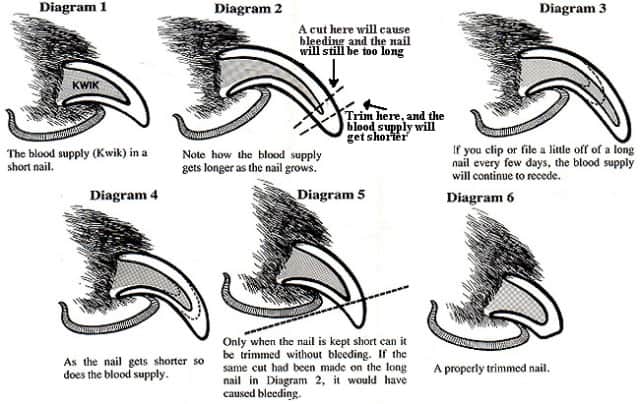
- You don’t want to cut the nails too short – the highly vascular quick will tell you in no uncertain terms when you’ve gone too short, and that’s really not something you want to experience. A rule of thumb is that your dog’s nails should just barely sound on the floors when they are trimmed to proper length.
- You don’t want the nails too long; this will cause deformities[3] in the phalanges (toe bones) and difficulty walking, and over time will result in lameness. Besides – it’s painful for the dog.
- Taking your dog for walks on asphalt will help to keep nails shortened[4] but should not be used in place of a proper pedicure.
- If you’ve taken your pooch for a grooming and his nails are cut perfectly, try to maintain them with a grinder weekly to eliminate the process of cutting, and keep the nail smooth and healthy.
- Cutting should be done at least monthly to maintain a healthy length.
Uh Oh, Here Comes the Blood
So you’ve nicked the quick.
It’s easy to tell if you have – the nail will start bleeding like Old Faithful, and you will probably start panicking.
Don’t forget – a panicked human leads to an excited canine.
No matter how careful you are, accidents can happen.
For starters, calm down. If you followed the directions, you have a small jar of styptic powder next to you, between the scissors and treats.
Start by giving a treat. What the heck – make it two.
Then, take a pinch of the yellowish powder, press it into the bleeding nail and hold firmly for a minute or two.
Repeat – starting with treat – until the bleeding stops.
Don’t wipe away any excess powder, and try to keep your furbaby calm for 15-30 minutes. Treats should help with this, too.
Depending on which paw is bleeding, giving your dog a chew toy can keep him distracted while the powder does its work.
Obviously, you may want to call it a day and re-approach the pedicure tomorrow.
Conclusion
Cutting your pup’s nails doesn’t have to be a detestable chore.
With some planning and patience – and a pile of treats – you can have the job done in a jiffy.
FAQs
What is the correct angle to cut a dog’s nails?
About a 45 degree angle.
Do long nails hurt dogs?
Yes. It can cause pain and other health issues if left uncut for long periods.
Does cutting dog’s nails hurt them?
Only if you do it wrong. If you follow the tips in this article, you shouldn’t have a problem. If you are still worried about cutting your dog’s nails, you can take them into a groomer or try using a Dremel to keep your dog’s nails in file (get it? Puns are fun).
How long is too long for dog nails?
They should not touch the ground when standing. If you can hear your pup click-clacking through the house, it’s probably time to for a doggie pedicure.
How painful is cutting a dog’s quick?
I don’t feel a thing but I can tell you that it hurts the dog a lot. There are a lot of nerves and blood vessels that end in the nail so if you happen to cut too short, you’re going to have a very unhappy and bloody dog.
Be conservative when you first start cutting your dog’s nails. Only take off a sliver at a time until you and your dog are comfortable with it and then work your way up.
How often should you cut dogs nails?
Weekly would be ideal but whenever you hear the click-clacking coming down the hall, you may want to get out the nail clippers.
Resources
- [1] https://pethelpful.com/dogs/How-to-Make-a-Dogs-Quick-Recede
- [2] https://www.petmd.com/dog/care/5-things-you-need-know-about-dog-dewclaws
- [3] https://www.whole-dog-journal.com/issues/19_4/features/Nail-Clipping_21430-1.html
- [4] https://familypet.com/how-do-dogs-naturally-trim-their-nails-when-walking-and-running-on-hard-surfaces-like-sidewalks/
- [5] https://www.akc.org/expert-advice/health/nail-neglect-can-lead-to-health-problems-for-your-dog/

